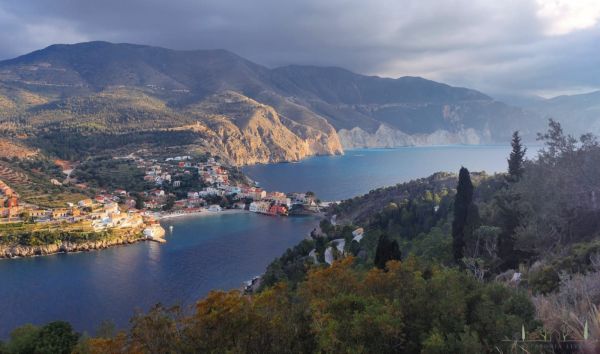The village of Assos is one of the most charming and well-known villages of Kefalonia. Like Agia Efimia and Fiskardo, it is famous for its timeless beauty, its pastel-coloured houses overlooking the sea and the many bougainvilleas that frame its picturesque views. On the hill overlooking the bay is one of the largest castles in all of Greece. The ruined walls of the fortress can still be seen today and inside it is possible to visit the ruins, unfortunately not valued as they deserve, of a citadel which was of great defensive importance for the island during the Venetian period. In 1584 the nobles of Kefalonia presented a petition to the Venetian Senate for a new fortress to be erected in the center of the island. The Castle of Saint George, at a short distance from Argostoli, was in fact not sufficient to defend the entire island from the Turkish threat and from pirate raids. Venice accepted the request and in 1593 began the construction of 2000 meters of walls which, surrounding the peninsula, made it impregnable. Even if it was possible to live and cultivate inside the citadel, the population decided not to move inside the walls. The absence of water sources and the distance from important sources of supply represented a problem not only in the event of prolonged sieges, but also for daily life. Unlike the castle of Saint George, Assos was not the site of battles and was used as the seat of the Venetian protectorate. Even today you can find the remains of Venetian houses, wells and irrigation systems as well as some interesting bells forged by a historic Venetian foundry. Until 1956 Assos Castle was used as a prison for political dissidents and was later abandoned. A large tourist center has recently been built inside the walls. The building is abandoned and already damaged. A real pity because, in addition to being unused, it has probably taken the place of a much older building, compromising the magical atmosphere of the place. In summer, the high temperature can make the ascent to the castle difficult. We suggest spending the day at the beach (Myrtos, not far away, can be a good option) and heading to Assos in the afternoon for a refreshing drink. Going up to the castle in the late afternoon will allow you to enjoy one of the most evocative sunsets on the island!
The villages around Argostoli are full of historical sites of great interest such as the Mycenaean tombs of Mazarakata, the Cyclopean walls of Krani, the castle of San Giorgio and the more recent Memorial to the Acqui Division. The Castle of Saint George is located above the village of Peratata and was built in the 12th century. However, the current ruins date back to the dominion of the Venetians, who wrested the fortress from the Turks at the end of the 1500s with the help of the Spaniards and the islanders. The Venetians fortified the walls and built a small village in front of the castle in the area now called Kastro. Due to the castle's elevated position, pirate ships could be located at a distance of up to 20 miles on a clear day. In the village, where locals and nobles lived, there were mansions, Orthodox and Catholic churches, schools. In the fortified citadel there were instead watchtowers, bastions, water cisterns, cisterns with boiling oil to spill on enemies, a hospital, food warehouses and even a prison. It is said that an underground tunnel also started from the castle and reached the Koutavos lagoon. In 1757 the Venetians decided to move the administrative headquarters from the castle to the hitherto insignificant settlement of Argostoli with the aim of developing trade by sea. The inhabitants consequently moved to the coast causing a progressive abandonment of the fortress. The castle was devastated not only by time and wars, but also by the strong earthquake that struck Kefalonia in 1953. Today the fortress has been partially restored and is a pole of attraction on the island not only for its historical value, but also for the enchanting panoramic view that can be enjoyed from its walls.

